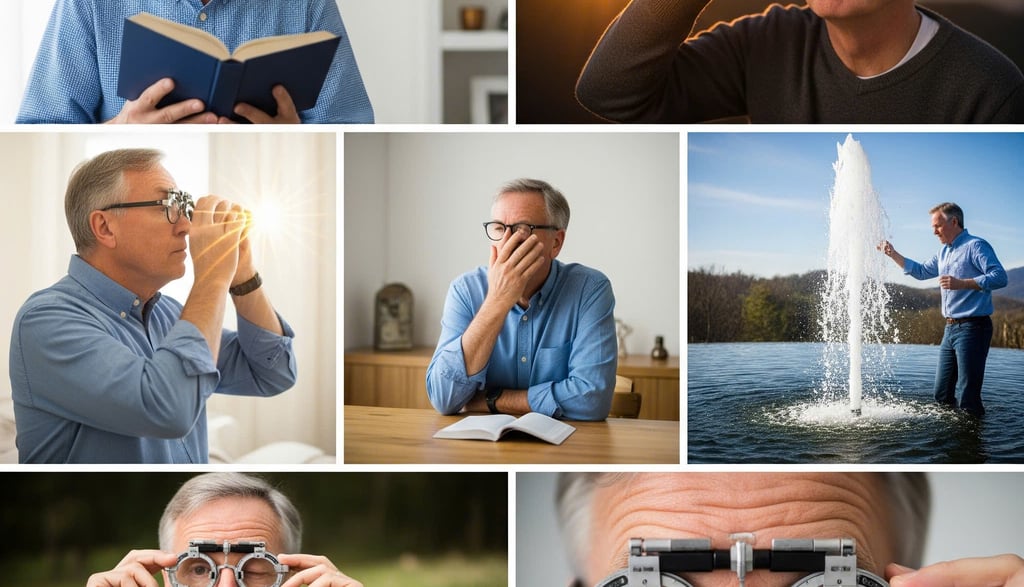A Middle-Aged Man's Journey to Natural Vision Recovery
3/17/20257 min read


Introduction: A Life Shrouded in Glasses
Throughout much of his adult life, the protagonist, a middle-aged man, faced the constant reality of impaired vision. From an early age, he struggled with refractive errors that necessitated the use of glasses. Initially, wearing glasses was a manageable inconvenience, but as the years progressed, his reliance on these corrective lenses grew more pronounced. The initial signs of vision problems manifested in the form of blurred words on the pages of books, difficulty recognizing faces from a distance, and strained eyes after prolonged periods of reading or screen time.
His journey through adulthood saw a gradual deterioration of his eyesight. What once was a minor inconvenience transformed into a significant barrier that limited his activities. Simple tasks, such as driving at night, navigating unfamiliar environments, or even enjoying outdoor activities, became increasingly daunting. He often found himself frustrated as the fog of glasses clouded his attempts to engage fully with the world around him. This reliance on corrective lenses not only affected his vision but also took a toll on his self-esteem. The feeling of being defined by glasses, coupled with the constant need to adjust or clean them, contributed to a sense of self-consciousness that permeated his daily interactions.
Amidst this struggle, a pivotal moment emerged, igniting a desire to reclaim his natural vision. This transformative realization occurred during a moment of reflection, where he envisioned a life free from the constraints imposed by glasses. It beckoned the question: could there be a path towards restoring his eyesight without reliance on artificial aids? The quest for an alternative means to regain his vision had begun, setting the stage for a journey filled with hope, exploration, and determination.
The Turning Point: Discovering Home-Based Vision Improvement
As John approached his mid-fifties, he began to experience a significant decline in his vision. What started as minor blurriness gradually transformed into daily challenges, impacting his work and personal life. Initially, he resorted to conventional solutions, such as prescription glasses and frequent visits to eye care specialists. However, he felt increasingly dissatisfied with these temporary fixes and yearned for a more permanent solution to his vision problems.
One evening, while browsing online for innovative approaches to vision correction, John stumbled upon a wealth of information regarding home-based vision improvement. This content spoke of natural techniques, exercises, and holistic approaches designed to enhance vision without relying solely on corrective lenses. Intrigued yet skeptical, he found himself diving deeper into the subject, researching natural remedies, eye exercises, and lifestyle modifications that promised better visual acuity.
During his research, John encountered narratives from individuals who had successfully transformed their vision using alternative methods. These testimonials presented a stark contrast to what he had been taught about vision care. He pondered whether it was truly possible to restore his sight through self-directed efforts, but doubts lingered in his mind. To address these concerns, he sought insights from practitioners in the field of natural vision improvement.
Consultations with experienced vision improvement coaches and attendance at workshops reinforced John's resolve to embark on this unconventional journey. In one particular workshop, he was introduced to the Bates Method and a variety of eye exercises, designed to engage and strengthen the eye muscles. These experiences served as a pivotal moment for John, solidifying his commitment to explore home-based vision enhancement further. He recognized that by investing time and effort into these techniques, he could take charge of his ocular health and work toward regaining his natural vision.
The Method: Techniques for Vision Improvement
In his journey towards regaining natural vision, the protagonist explored a variety of techniques that combined exercises, relaxation methods, visualizations, and dietary changes to support eye health. One of the cornerstone methods he employed was the Bates Method, devised by Dr. William Bates. This technique emphasizes the importance of relaxation and visual habits to improve eyesight. The protagonist incorporated specific Bates exercises, such as palming, where he would gently cup his hands over his eyes to block out light and induce relaxation, often doing this for several minutes a day.
Alongside the Bates Method, he adopted eye relaxation techniques into his daily routine. This included periodic breaks during tasks that required prolonged focus, such as reading or using electronic devices. Every hour, he would take a moment to close his eyes or focus on distant objects to alleviate strain. Visualizations also played a crucial role; he practiced imagining clear, vibrant images to stimulate his visual cortex and reinforce positive mental imagery associated with good sight.
Additionally, dietary changes were instrumental in supporting his vision improvement efforts. The protagonist educated himself about nutrients that benefit eye health, such as omega-3 fatty acids, vitamins C and E, and beta-carotene. Consequently, he integrated more leafy greens, nuts, and fish into his meals, ensuring that his diet complemented his vision exercises and relaxation techniques.
To maintain consistency and motivation, he established a structured daily routine. Each morning, he would perform his Bates exercises, followed by a balanced breakfast rich in eye-healthy nutrients. He documented his progress in a journal, noting any changes in his vision and his emotional state, which further encouraged him to persist in these practices. By systematically integrating these diverse methods into his life, he contributed significantly to his quest for natural vision recovery.
Experiencing Challenges: Setbacks and Breakthroughs
The journey to natural vision recovery is rarely linear; it is often marked by numerous challenges that test one’s resolve and commitment. For the middle-aged man in our case study, the path was fraught with moments of both frustration and remarkable breakthroughs. Initially, his vision recovery exercises were physically demanding, contributing to discomfort that at times could be disheartening. This discomfort, which was often compounded by an overwhelming sense of fatigue, led him to question the feasibility of his chosen approach. Progress, he found, was not only slow but also accompanied by days where the vision clarity felt worse rather than better.
Despite these setbacks, there were also significant breakthroughs that revitalized his determination. For instance, after weeks of persistence with eye exercises, he experienced a day where he could read small print without strain—a pivotal moment that transformed his attitude. These instances of improvement became crucial in reinforcing his belief in the efficacy of the natural recovery approach. They served as reminders that despite the physical and psychological hurdles, progress was possible. This duality of setbacks and successes revealed profound insights about resilience and adaptability.
The Evolution: Tracking Progress and Milestones
The journey toward natural vision recovery is not merely a physical transformation, but also an emotional and intellectual one. For our protagonist, this evolution began with a keen awareness of his initial visual limitations and an unwavering commitment to improvement. Tracking progress became essential to understand the efficacy of his methods and maintain motivation along the way. He employed a variety of techniques to monitor his improvement, which included regular vision tests and insightful personal reflections.
One of the first significant milestones he achieved was the notable reduction in his dependence on glasses. Initially, he relied on corrective lenses for almost all activities, from reading to simple daily errands. However, as he diligently practiced the vision-enhancing exercises developed from his research, he began to notice a gradual improvement in his sight. Each time he found himself reaching less for his glasses to read a book or view distant objects, it reinforced his belief in the journey toward vision recovery.
Clarity in his vision marked another pivotal moment on his path. The protagonist utilized simple, yet effective, vision tests, such as the Snellen chart, to measure his visual acuity. He meticulously recorded his results over time, which increasingly showcased mild improvements that culminated in excitement and joy. Additionally, with better vision came the newfound ability to engage in activities he once avoided, such as hiking and gardening. These joyful experiences were not only milestones in terms of visual improvements but also represented a reclaiming of life and the pleasures it holds.
Beyond the quantitative measurements, personal reflections proved vital in capturing the emotional weight of these milestones. Journaling allowed him to document both minor victories and setbacks, creating a comprehensive narrative of resilience. This reflective practice provided him the opportunity to celebrate each small success while reinforcing his resolution during challenging times. Ultimately, tracking his journey through these milestones solidified the understanding that natural vision recovery is a continuous process, rich with emotional fulfillment and personal growth.
Transformation: Life Beyond Glasses
The journey of regaining sight through natural methods profoundly transformed the protagonist's life, reshaping not only his vision but also his perception of the world around him. Prior to this transformation, he relied heavily on glasses, which had become a symbolic barrier, restricting his engagement with everyday activities. With the removal of this barrier, he found himself rediscovering the simple joys of life. Activities like hiking, reading without discomfort, and engaging in outdoor sports became a reality rather than a distant dream, allowing him to embrace a more active lifestyle.
In addition to the physical changes, there was a marked improvement in the protagonist's personal relationships. The regained confidence that came with his clearer vision allowed him to engage more meaningfully with friends and family. Conversations flowed easier and more genuinely, as he no longer had to fumble with glasses during interactions. This newfound clarity brought about a stronger emotional connection with his loved ones, deepening bonds and enhancing shared experiences.
As his confidence surged, so too did his sense of self. The protagonist transitioned from feeling limited by his vision impairment to advocating for natural vision recovery methods. His journey inspired him to educate others on these techniques, ultimately fostering a supportive community focused on holistic improvement. He began hosting workshops, sharing not only his personal story but also practical advice on maintaining eye health through natural practices. This shift from a passive recipient of vision correction to an active promoter of natural methods encapsulated the essence of transformation; regaining his eyesight redefined his existence and provided a platform for helping others reclaim their vision.
Conclusion: A New Vision for Life
As the journey of regaining sight concludes, it is important to reflect on the transformative experiences gained along the way. The protagonist, facing the challenges posed by deteriorating vision, found that perseverance was a vital component in his quest for recovery. This journey was not merely about improving eyesight; it became a holistic process encompassing mental fortitude, emotional resilience, and a commitment to self-care. Embracing open-mindedness allowed him to explore various methods for natural vision recovery, challenging preconceived notions about traditional practices.
Throughout this experience, the protagonist discovered that the path to better vision is also a path towards improved overall health and wellness. By prioritizing eye health and integrating lifestyle changes, such as diet modifications and relaxation techniques, he was able to foster a deeper connection with his body and its needs. This newfound awareness resulted in a significant shift in his perspective on health, viewing it as an ongoing journey rather than a destination. The sense of empowerment derived from taking control of his well-being has become a cornerstone of his life moving forward.
This narrative serves as a reminder that the possibilities for natural vision improvement can be vast and greatly influential. Readers are encouraged to trust in their own journeys, to remain open to the diverse approaches available, and to maintain determination in their pursuit of recovery. Each individual's path may differ, but the collective belief in the potential for change can encourage a new vision for life. Thus, embracing the lessons learned along this journey not only enhances one's eyesight but also enriches life itself, paving the way for a more fulfilling and health-conscious existence.
